Discover the hidden charm of New England through the 17 Orange Birds of Connecticut, each with their unique allure and captivating beauty. From the surprising variation among familiar species to the rare visitors that treat us with their presence, this guide to the 17 orange birds of Connecticut offers a fascinating insight into the state’s rich birdlife.
Complete with a free photo guide, we invite you to embark on this exciting ornithological journey and experience firsthand the wonder these captivating creatures bring. Get your binoculars ready and let’s take flight!
Orange Birds Found In Connecticut
Connecticut’s diverse geography – spanning coastal marshes, lush forests, and meandering rivers – creates a rich mosaic of habitats, making it a birdwatcher’s paradise teeming with a vibrant array of species, including an impressive variety of orange birds.
American Redstart


| Feature | Measurement |
|---|---|
| Scientific Name | Setophaga ruticilla |
| Length | 4.3 to 5.5 in |
| Wingspan | 6.3 to 9.1 in |
| Weight | 8.6 g |
The American Redstart is a lively warbler known for its vivid colors and active hunting style, often seen flitting about, fanning its tail to startle and catch insects.
Appearance: Adult male American Redstarts boast striking black plumage with bright orange patches on the sides, wings, and tail. Females and immature males have grayish-olive upperparts with yellow patches in the same areas where the males display orange.
Diet: American Redstarts are primarily insectivores. They actively forage for flying insects, as well as caterpillars and spiders, often using their colorful tails to startle prey and make them easier to catch.
Reproduction: The female American Redstart builds a cup-shaped nest in the fork of a tree branch. Typically, she lays a clutch of 3 to 5 eggs. The female takes on the primary responsibility of incubating the eggs, while both parents participate in feeding the fledglings after they hatch.
American Robins


| Feature | Measurement |
|---|---|
| Scientific Name | Leptotila plumbeicep |
| Length | 10.6-11.8 in |
| Wingspan | — |
| Weight | 160-200 g |
The American Robin is a widely recognized bird species known for its melodious song and early bird tendencies.
Appearance: American Robins are medium-sized birds with a distinctive appearance. Both males and females sport a gray to brown back and a warm red to orange breast and belly and gray wings. They also have a characteristic white eye-ring and a black head, but males are usually darker than females.
Diet: American Robins have a diverse diet that changes depending on the season. In summer, they feed heavily on earthworms, beetles, and other invertebrates, which they catch on the ground. During winter, they mostly eat fruits and berries.
Reproduction: American Robins usually build their nests in trees or shrubs, but they are also known to nest on human-made structures. The female lays a clutch of about 3 to 5 eggs, which she incubates for about 12 to 14 days.
Barn Swallow

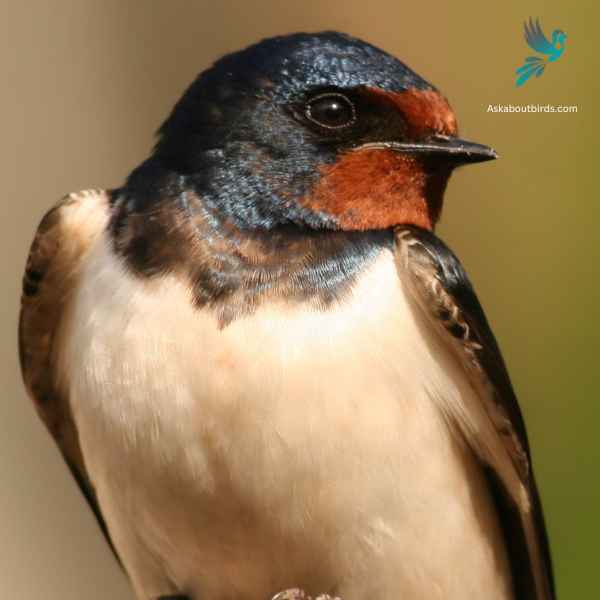
| Feature | Measurement |
|---|---|
| Scientific Name | Hirundo rustica |
| Length | 6.5–7.5 in |
| Wingspan | 12.5–13.5 in |
| Weight | 16–22 g |
The Barn Swallow is a sleek, agile bird renowned for its graceful flight patterns and iconic forked tail, often seen darting over fields and water bodies in search of flying insects.
Appearance: Barn Swallows have deep blue, almost iridescent, upperparts and a rufous to tawny underbelly. Their distinctively forked tail and long wings give them a streamlined look. Both males and females have a similar appearance, though males often exhibit slightly brighter colors and a deeper fork in the tail.
Diet: Barn Swallows feed primarily on flying insects, which they catch in mid-air during their agile and acrobatic flights. Their diet includes flies, beetles, moths, and other small flying insects.
Reproduction: Barn Swallows are known for building their mud nests on man-made structures, particularly barns, bridges, and eaves. The nest is cup-shaped and made from mud pellets, often lined with feathers. The female lays a clutch of 4 to 6 eggs.
Baltimore Oriole


| Feature | Measurement |
|---|---|
| Scientific Name | Icterus galbula |
| Length | 6.7–8.7 in |
| Wingspan | 9.1–12.6 in |
| Weight | 22.3-42 g |
The Baltimore Oriole is a stunning bird, best known for its vibrant coloration and its rich, whistling song.
Appearance: The male Baltimore Oriole is notable for his bright orange and black plumage and black and white wing bars, a stark contrast to the more muted yellow-brown coloration of the female. Both sexes, however, have long pointed bills and white bars on their wings.
Diet: Baltimore Orioles have a diverse diet that includes insects, fruits, and nectar. Their preference for sweet juices and fruit pulp often brings them to backyard feeders offering oranges and jelly.
Reproduction: The female Baltimore Oriole is responsible for building the distinctive hanging nest, often woven together from fine materials like hair and grass. These nests are usually high in trees to avoid predators. The female lays 3-7 eggs, which are incubated for about two weeks.
Orchard Oriole
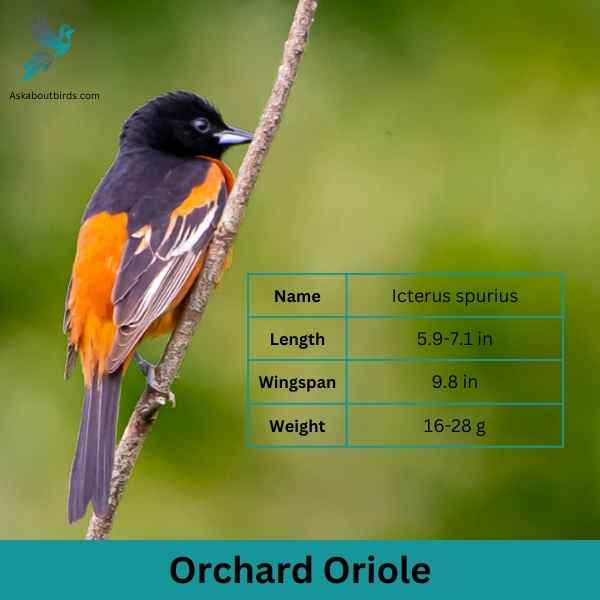
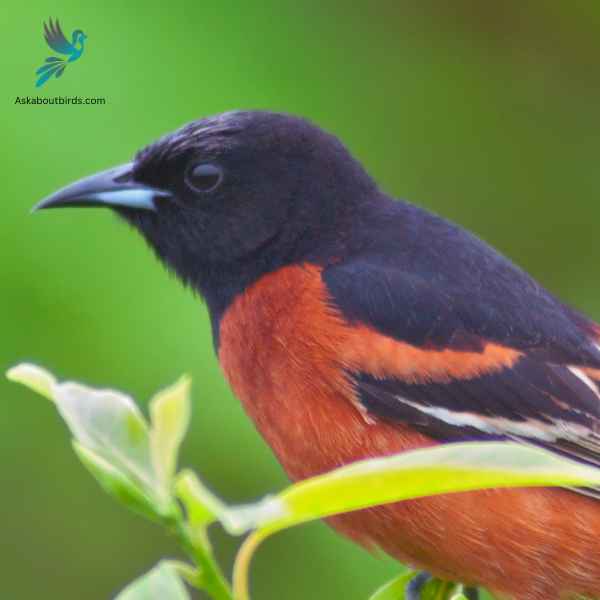
| Feature | Measurement |
|---|---|
| Scientific Name | Icterus spurius |
| Length | 5.9-7.1 in |
| Wingspan | 9.8 in |
| Weight | 16-28 g |
The Orchard Oriole is a small songbird noted for its distinctive coloration and melodic song.
Appearance: Male Orchard Orioles are a striking sight with their dark chestnut body and black head and black and white wings, while females and immature males are olive-green and feature a yellowish underpart. The species is often recognized by its slender body and pointed bill.
Diet: The diet of the Orchard Oriole consists primarily of insects, fruits, and nectar. They are adept at catching insects mid-air and are also known to sip nectar from flowers, aiding in pollination. When fruits are in season, they make up a substantial portion of the bird’s diet.
Reproduction: Orchard Orioles often nest in open woodlands and orchards, hence their name. The female is responsible for building the nest, typically choosing a location in a tree or shrub. The female lays a clutch of 4 to 6 eggs, which she incubates for about two weeks.
Red-breasted Nuthatch

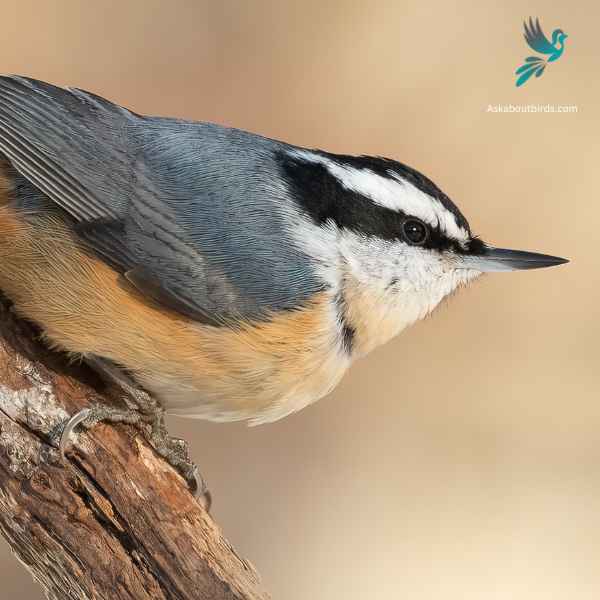
| Feature | Measurement |
|---|---|
| Scientific Name | Sitta canadensis |
| Length | 4.3–4.7 in |
| Wingspan | 8.3 in |
| Weight | 0.3–0.5 oz |
The Red-breasted Nuthatch is a small, agile songbird, known for its ability to move headfirst down tree trunks while searching for food.
Appearance: This bird boasts a slate-blue back and a pale rust-red underside. A prominent black stripe runs through the eye and is bordered above by a white eyebrow. Their sharp, pointed bill is characteristic of the species.
Diet: Red-breasted Nuthatches primarily feed on insects and seeds, especially those from coniferous trees. They have a fondness for large seeds, which they wedge into bark crevices to hack open with their bills.
Reproduction: These birds construct nests in natural tree cavities or abandoned woodpecker holes, often lining the entrance with resin. This is thought to deter predators or competitors from entering. The female typically lays a clutch of 5 to 6 eggs, and both parents partake in feeding the chicks once they hatch.
Eastern Towhee

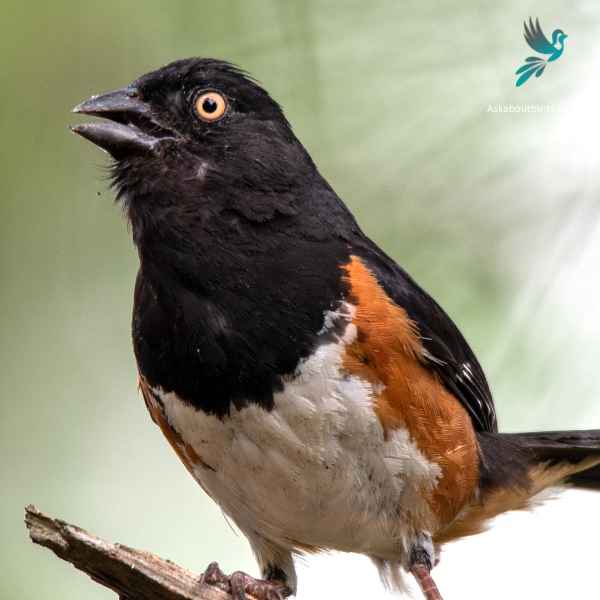
| Feature | Measurement |
|---|---|
| Scientific Name | Pipilo erythrophthalmus |
| Length | 6.8 to 9.1 in |
| Wingspan | 7.9–11.8 in |
| Weight | 32 to 53 g |
The Eastern Towhee is a distinctive songbird known for its unique calls and eye-catching coloration.
Appearance: Male Eastern Towhees are characterized by a striking combination of a black head, back and tail, contrasting with a white belly and rufous flanks. Females sport similar patterns but instead of black, they have a rich brown color. Both genders have red eyes, lending a special charm to their overall appearance.
Diet: Eastern Towhees primarily feed on a variety of insects, seeds, and berries. Their diet is quite diverse, taking advantage of seasonal offerings, which includes beetles, caterpillars, spiders, acorns, grass seeds, and various fruits and berries.
Reproduction: Eastern Towhees build their nests on or near the ground, often in a shrub or a small tree. The female lays around 3-5 eggs and takes the primary role in incubating them over about 12-13 days.
Blackburnian Warbler
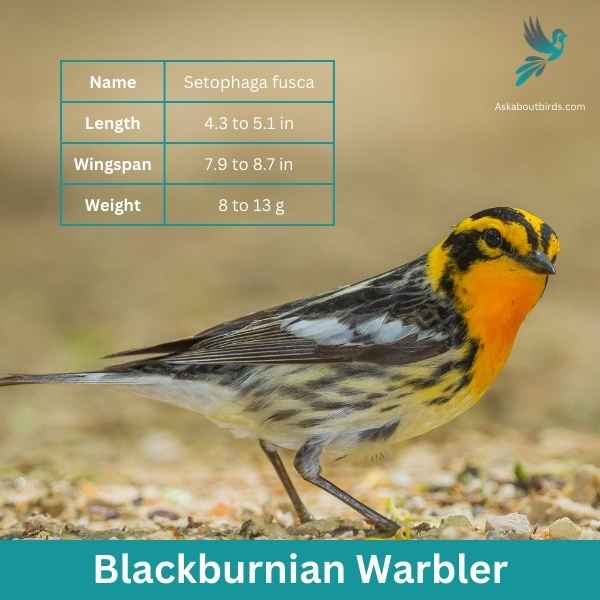

| Feature | Measurement |
|---|---|
| Scientific Name | Setophaga fusca |
| Length | 4.3 to 5.1 in |
| Wingspan | 7.9 to 8.7 in |
| Weight | 8 to 13 g |
The Blackburnian Warbler is a strikingly colored songbird that captivates observers with its vivid plumage, especially during the breeding season. Often found flitting high in the treetops of North American forests, its melodious song is as enchanting as its appearance.
Appearance: Male Blackburnian Warblers are distinguished by their fiery-orange throats, contrasting sharply with a black face, crown, and streaked back. They also have white underparts with black streaks on the sides. Females have a more muted coloration, with a yellowish or pale orange throat and less pronounced streaking.
Diet: Blackburnian Warblers primarily feed on insects and spiders. They are adept at foraging in the canopy, where they glean insects from the surface of leaves and branches or catch them mid-air in quick, agile flights.
Reproduction: Blackburnian Warblers build their nests high up in coniferous trees, often on horizontal branches. The nest is a neat cup made of twigs, grass, and moss, lined with softer materials like hair or feathers. The female lays a clutch of 4 to 5 eggs and takes the lead in incubation.
Where to Spot Connecticut’s Orange Birds
Connecticut, with its varied habitats from coastal shores to lush forests, is a haven for birdwatchers, offering numerous spots teeming with a diverse array of bird species, including an assortment of orange birds. Here are some top locations that every bird enthusiast should explore:
- Hammonasset Beach State Park: With over two miles of shoreline, this park in Madison is an excellent site for spotting coastal and migratory birds, including the likes of the Red-breasted Merganser and the Northern Harrier. Birdwatchers can take advantage of the nature center and observation platforms.
- White Memorial Conservation Center: Located in Litchfield, this conservation center houses various habitats, attracting a range of bird species. It’s an ideal spot for spotting Wood Ducks, Great Blue Herons, and Red-shouldered Hawks, amongst others.
- Bent of the River Audubon Center: Nestled in Southbury, this sanctuary offers a pristine habitat for birds and an incredible birdwatching experience. The various trails throughout the preserve provide views of many bird species, including warblers and sparrows.
- Sherwood Island State Park: As Connecticut’s first state park, Sherwood Island in Westport offers both a rich history and rich birdlife. The park’s diverse habitats, from wetlands to woodland, attract a wide array of bird species.
- Stewart B. McKinney National Wildlife Refuge: Stretching along the state’s coastline, this refuge is composed of multiple units, each with its unique birdlife. It’s especially notable for waterfowl and shorebirds, making it a must-visit spot for birdwatchers.
| New York’s Orange Birds | Central Park, Montezuma National Wildlife Refuge, Jamaica Bay Wildlife Refuge |
|---|---|
| Massachusetts’ Orange Birds | Plum Island, Mount Auburn Cemetery, Quabbin Reservoir |
| Rhode Island’s Orange Birds | Sachuest Point National Wildlife Refuge, Block Island National Wildlife Refuge, Trustom Pond National Wildlife Refuge |
FAQs on Orange Bird Species Found in Connecticut
How long do Baltimore Orioles stay in CT?
Baltimore Orioles are typically found in Connecticut during the spring and summer months. These birds migrate to the region to breed and are commonly seen until late summer. After which, they head south for the winter months. If you’re looking to spot them, they are often attracted to backyard bird feeders, especially ones offering nectar or fruit.
What bird has bright orange on it?
The bird renowned for its bright orange plumage is the Baltimore Oriole. This vibrant color, paired with black wings and white wing bars, makes it stand out from other birds. Apart from Orioles, the Northern Cardinal is another common backyard bird that has a rusty orange breast, especially evident in immature birds.
What is a black bird with orange in Connecticut?
In Connecticut, the bird that displays a mix of black and bright orange patches is the Baltimore Oriole. Their unmistakable combination of bright orange plumage contrasted with black wings and tail feathers makes them a memorable sight throughout Connecticut, especially near bird feeders during warmer months.
Where are the Orioles in CT?
Throughout Connecticut, Orioles, particularly Baltimore Orioles with their bright orange patches, can be spotted in wooded areas and gardens. They are common backyard birds during the spring and summer months, often visiting backyard bird feeders. Offering them nectar, fruits, or even jelly can increase your chances of observing these vibrant birds up close.
What birds can I expect to see near deciduous trees during the winter months in my region?
During the winter months, deciduous trees often become a gathering point for various bird species seeking shelter or food. Among these winter birds, yellow birds, specifically those with bright yellow feathers, stand out. To attract and observe them closely, consider setting up a bird feeding station nearby, as it can serve as a hub for these vibrant avian visitors.





